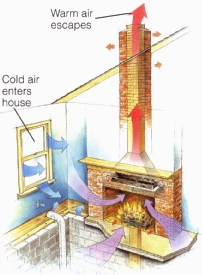The Problem Heat (and money) go up the chimney. Despite its undeniable aesthetic appeal and that toasty feeling on your face, a crackling wood fire in a traditional fireplace isn't your friend. It’s sending most of its heat straight up the chimney, and its appetite for oxygen can actually displace the warm air in your home with cold, resulting in a net energy loss. To keep smoke from back-drafting into the house, a fireplace has to draw air from the outside. In most homes, this means cold air will enter through leaky windows and other openings, forcing warm air up the chimney. In a weather-tight home, a window will have to be opened to provide air for combustion. |
 |
Solution #1 Add glass door and air-intake vent. If your fireplace sits above grade in an exterior wall, and if local codes allow it, install a box vent, lined with fireproof material, to provide combustion air directly to the fire. This helps prevent warm inside air from being lost up the chimney. Glass fireplace doors radiate the fire’s heat but block the loss of interior air. Two modifications can interrupt a fireplaces cycle of inefficiency by stopping the loss of warm inside air. The first step is to provide an alternate source of combustion air by adding a vent that opens directly into, or in front of, the firebox. Second, a set of glass fireplace doors prevents interior air from entering the chimney. |
 |
Solution #2 Wood-burning insert. Similar in function to a freestanding wood stove but nested inside the fireplace opening, a wood-burning insert offers much greater efficiency than an open fireplace. The key is a heat-exchange chamber that surrounds the firebox; room air, helped by an electric blower, enters this chamber for heating and recirculation. Adjustable vents in the insert doors provide combustion air for the firebox, but air that enters the heat-exchange chamber is heated and returned to the room. The smoke stream exits through a metal flue insert so no cross- contamination occurs with the air circulating through the heat-exchange chamber. |
 |
Solution #3 Gas-fired insert. Although it relies on a heat-exchange chamber much the way a wood-burning insert does, a gas-fired fireplace insert has a sealed combustion chamber, so no interior air is used for combustion. Instead, two metal flue inserts are used: one for combustion air intake and one for an exhaust vent. It’s convenient and efficient. With no wood to haul in and no ashes to clean out, a gas-burning fireplace insert offers convenient use of a converted fireplace. The combustion chamber is sealed off from the home’s interior; its heat is captured by air in the surrounding exchange chamber and circulated by an electric blower. |
 |


